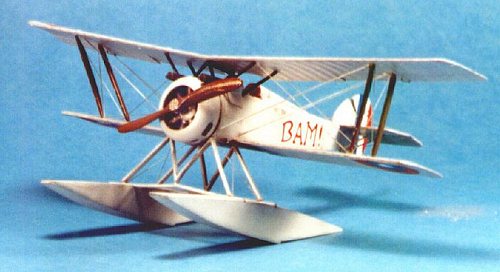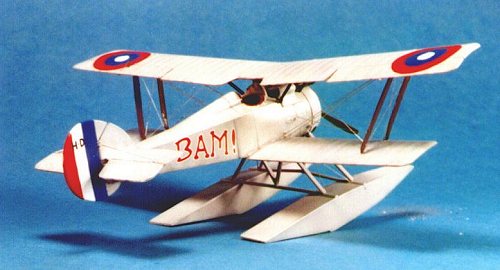
|
KIT # |
8039 |
|
PRICE: |
$29.98 |
|
DECALS: |
See review |
|
REVIEW : |
|
|
NOTES: |
Profipack |

|
HISTORY |
 The Hanriot
H.D. series of single seat scout first appeared in late 1916 as a proposed
replacement for the Nieuport 17 series, and were direct competitors with the
S.P.A.D. S.VII fighter, which was the airplane selected by the French Air Force
to become its main fighter. The single seat landplane was ordered by the Italian
Air Force, and it was built under license in Italy through the end of the war;
it was also used in limited numbers by the Belgian Air Force. The Hanriot H.D.2
was a maritime development of the land-based H.D.1, with a more powerful engine,
armament of two machine guns instead of one, and a larger rudder. They served
from the Fall of 1917 with the Dunquerque Squadron, where they undoubtedly ran
across their opposite numbers, the Albatros W.4 and the Hansa-Brandenburg W.12
floatplane fighters, as they sought to protect the larger Allied flying boats
used to hunt the Zeebrugge-based U-boats. The H.D.2 remained in service with the
Aviation Maritime for several years after the end of the war.
The Hanriot
H.D. series of single seat scout first appeared in late 1916 as a proposed
replacement for the Nieuport 17 series, and were direct competitors with the
S.P.A.D. S.VII fighter, which was the airplane selected by the French Air Force
to become its main fighter. The single seat landplane was ordered by the Italian
Air Force, and it was built under license in Italy through the end of the war;
it was also used in limited numbers by the Belgian Air Force. The Hanriot H.D.2
was a maritime development of the land-based H.D.1, with a more powerful engine,
armament of two machine guns instead of one, and a larger rudder. They served
from the Fall of 1917 with the Dunquerque Squadron, where they undoubtedly ran
across their opposite numbers, the Albatros W.4 and the Hansa-Brandenburg W.12
floatplane fighters, as they sought to protect the larger Allied flying boats
used to hunt the Zeebrugge-based U-boats. The H.D.2 remained in service with the
Aviation Maritime for several years after the end of the war.
Following U.S. entry into the war, the U.S. Navy sent several pilots to serve with the French naval flights to gain operational experience, and LT Bamberry was one of them. I have not been able to find out that much about either the pilot or the US detachment and their exploits; if any reader knows where to find this information, please contact me.
|
THE KIT |
Eduard released the floatplane version of the Hanriot shortly after the release of the Profipack version of the H.D.1 landplane in 1999. The kit comes on three trees of dark grey plastic with clean, crisp molding, and includes a large resin rudder for the H.D.2; two of the trees are the same as the land-based H.D.1, with the third tree carrying the parts for the twin floats and their associated bracing. Decals are included for two French and two American-flown aircraft.
|
CONSTRUCTION |
 I elected
to start with the floats, since they were going to take a bit of putty to get
them smooth, Assembly was quick and I set them aside after applying the putty.
I elected
to start with the floats, since they were going to take a bit of putty to get
them smooth, Assembly was quick and I set them aside after applying the putty.
I then turned to the cockpit, using the photo-etch fret which provides more delicate interior details and a better-looking seat than the injection-molded parts. The cockpit is simple, and was quickly assembled following the kit instructions. I glued the fuselage together, and also attached the lower wing at this time. I lightly puttied the centerline seam and set this aside to dry.
I then cut the control surfaces loose from wings, and horizontal and vertical stabilizers (being very careful with the resin rudder), then glued them back on after repositioning.
I sanded and filed the seams of the floats and the fuselage when they were all dry, then covered them with a coat of Mr. Surfacer 500, which I lightly sanded smooth after it had dried. I then attached the horizontal stabilizer and rudder, and we were ready to paint.
|
PAINT & DECALS |
Painting:
The kit instructions call for the cowling and forward fuselage to be aluminum, with the rest of the airframe grey. I do not think this is correct, since the aluminum would be natural metal, and could not have survived long in a saltwater environment. More logically (and like most European naval aircraft) it was likely painted light grey on all metal surfaces for corrosion control, while the rest of the airframe was thd standard Hanriot light silvery grey, which is the way I painted this model. Anyone who cares to contradict this is welcome to present their evidence. I painted the floats and struts light grey like the forward fuselage, the interplane struts wood brown and the cabane struts black, per the kit instructions. The engine was painted several shades of Testor's Metalizer. Once everything was dry, I shot two coats of Future and set it aside for the night.
Decals:
 I decided
to use the markings for Lt. Bamberry, since they were the most colorful of those
offered. The kit decals are printed by Cartograph, and while they were a bit
thick they went on with no difficulty and snugged down under Micro-Sol.
I decided
to use the markings for Lt. Bamberry, since they were the most colorful of those
offered. The kit decals are printed by Cartograph, and while they were a bit
thick they went on with no difficulty and snugged down under Micro-Sol.
Final Assembly:
I glued the cabane struts and interplane struts into position, then glued the float assembly together, test-fitting it for final attachment to the fuselage once the upper wing was on.
The machine guns with their fairings and the cockpit windscreen were attached; the upper wing went on with no trouble, using cyanoacrylate for all of this. I then attached the engine and cowling.
The floats went on with no trouble. The engineering of this kit is among the best of any World War I model, and fully up to the kind of standards one expects from Hasegawa or Tamiya kits. Once the model was assembled, I shot one final coat of "flat Future" - a mixture of 30% Tamiya Flat Base and 70% Future, to give a semi-gloss finish that one would expect in a marine environment.
Rigging:
Using the boxart and the rigging guide in the instructions, I attached my high-E guitar string rigging in about an hour and set everything aside after I attached the prop.
|
CONCLUSIONS |
This is a fun project, and the model is much easier to create than it might look. As such, it is a good model for the fledgling World War I modeler who has done a "slammer" like the Roland C.II, graduated to the Albatros D.III, and is looking for a bit of a challenge in a new project.
If you would like your product reviewed fairly and fairly quickly, please contact the editor or see other details in the Note to Contributors.